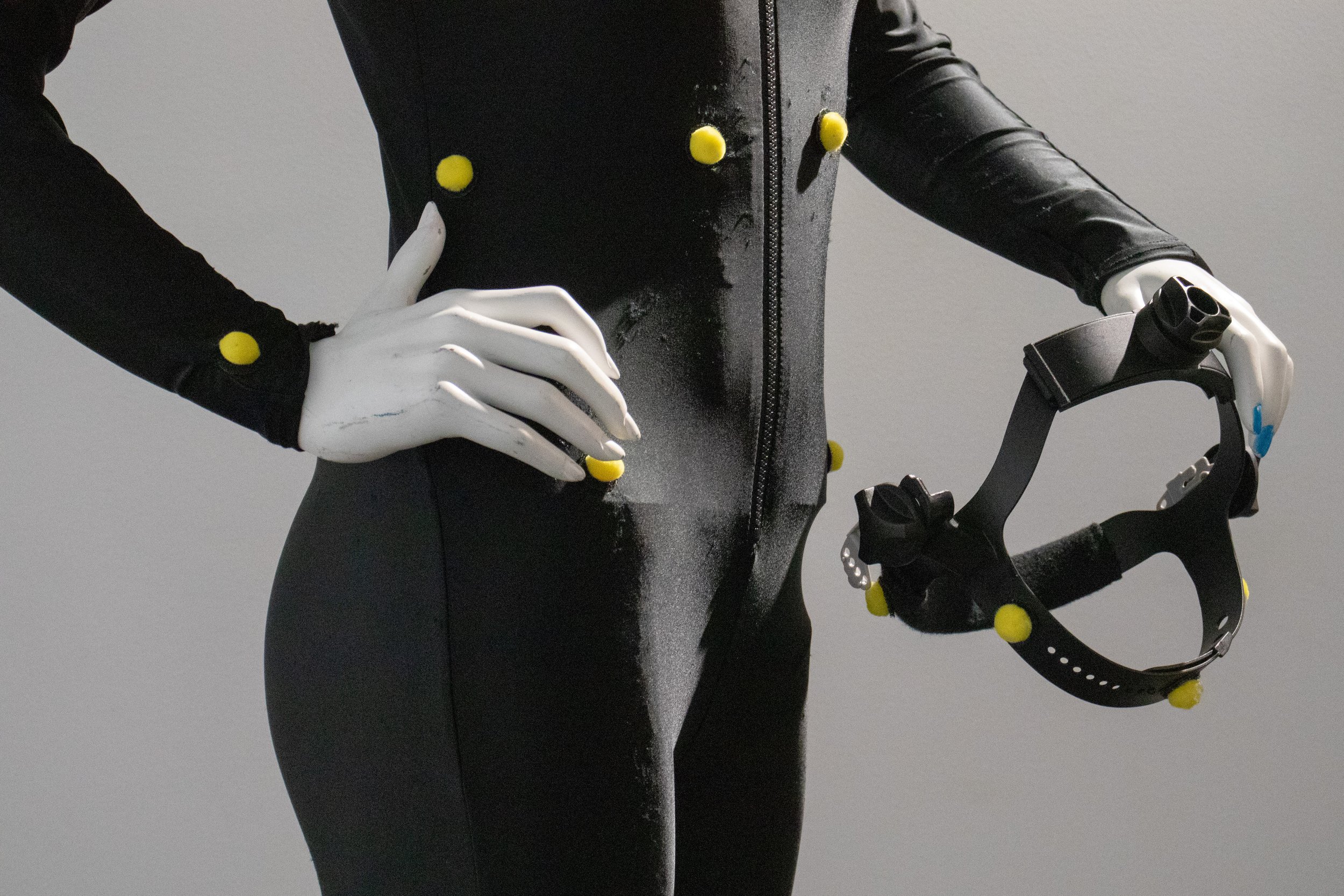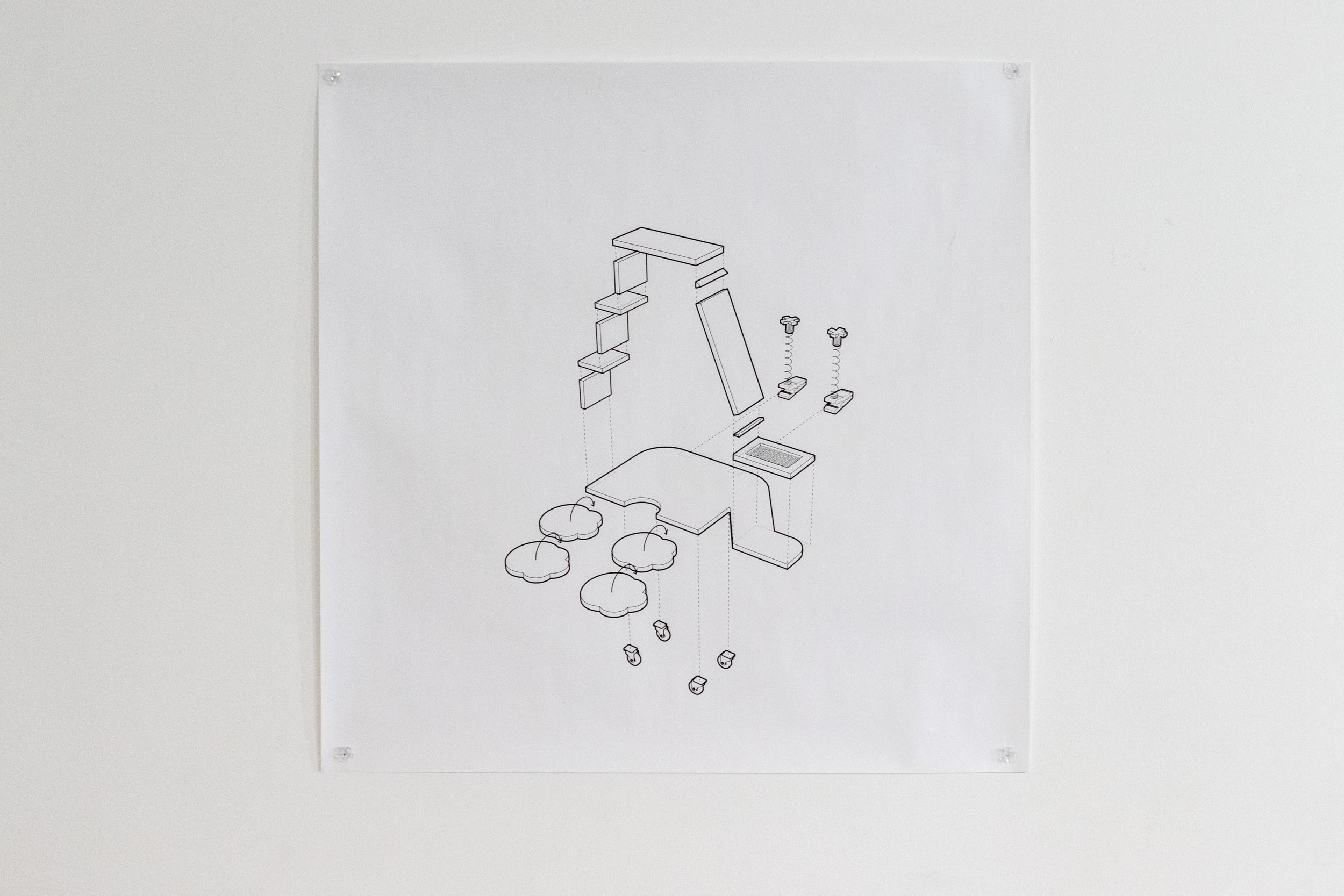Neither Here Nor There
Lau Wai & Huidi Xiang
Co-Curated with Elisa Gutiérrez Eriksen
September 9 - October 16, 2022
Press Release (teia / typed)
Exhibition Checklist
“Our body, to the extent that it moves itself about, that is, to the extent that it is inseparable from a view of the world and is that view brought into existence, is the condition of possibility, not only of the geometrical synthesis, but of all expressive operations and all acquired views which constitute the cultural world”- Maurice Merleau-Ponty
Maurice Merleau-Ponty viewed the body as the principal location for knowing the world and maintained that one could not disconnect the body and that which it perceived.[1] In contrast, we now encounter forms of knowledge that remove the body from its original place/space of production, positioning data and information as the base for creation of an ever-evolving world. The perception of and interaction with the body -or with other bodies and objects- has taken a new significance when speaking about virtuality. Although based in materiality, there is an assumption that what we’re seeing is not the “real thing,” but only one of its many possible forms of representation.
As object-makers, Lau Wai and Huidi Xiang both understand the limitations that objects have based on the spaces they must fill (in a studio, in a gallery, in someone’s home), the uniqueness of said object, and how those factors, in addition to market conditions such as scarcity, affect an object’s economic value. When one thinks about scarcity, it’s often in terms of supply and demand, but it is rarely approached from a mobility perspective. How does the location of a body affect its access to resources, and what happens when a body is transported to a virtual world? And if the macrocosm where virtuality situates itself is thought of as an empty void, then could it also be infinitely filled?
But as the physical and virtual become inescapably intertwined, artificial scarcity has become an instinctive choice made by those who stand to profit from limited resources, both material and mobile. Yet, tokenized digital assets on the blockchain, one form of artificial scarcity, offer an ownership model that does not preclude others from consuming/enjoying/partaking while enabling artists to expand their agency, exposure, and distribution. Bodies can now adopt new dimensions that render them vast, multiple, and full of possibilities and expressions outside of binary[2] definitions while creating a more fluid definition of scarcity and abundance. In the same way, the knowledge that bodies produce and consume challenge form, place, and space, situating both bodies and knowledge among fractured temporalities.
In Neither Here Nor There, the artists translate and develop ideas between the digital and physical world to create a hybrid space where connections and disconnections occur between the two. Using references to popular culture, classic cartoons, and Hollywood films, their practices converge in their exploration of the virtual and physical realms, paying special attention to the crossings between worlds and the simultaneities that happen in them. While Xiang references post-humanist[3] architectural ideas, using model kit cards as a way of materializing cultural phenomena (Playbour Objects Model Kit Cards), Lau contests the idea of embodiment and representation using echoes of her own digitized body, fragmented and multiplied, to the point of disappearance(////// rehearsal \\\\\).
Two gallery spaces (virtual and physical) echo each other not as a pure repetition, but as parallel lanes that alternate and evolve as they adopt and investigate formal and conceptual languages. Virtual objects stand in for their counterparts in the physical gallery and vice versa. Scarcity can lead to creativity, playfulness, and ingenuity when makers have limited means. Small colored pom-poms adorn a diving suit to create an imitation motion capture outfit, and hand and CNC routed kitcards create a door for their expansion, not only as objects but as suggestions for other interactive relationships[4] and explorations.
The use of humor and the absurd in both their practices establish bridges, not only to create new physical memories with digital tools (or perhaps the other way around), but to engage with a world that is literally and existentially falling apart. From a position of joy and play, the works of Xiang and Lau contest notions of reality, scarcity, and agency, and emphasize the frailty inherent in the relationships between representation and embodiment. Through this, they create a space to understand reality as something that neither exists here or there (wherever that is) but in an amalgamation-location that includes both ourselves and the echoes of our existences.
[1] Phenomenology of Perception by Maurice Merleau-Ponty [2] Glitch Feminism: A Manifesto by Legacy Russell [3] “In the posthuman understanding of architecture, discursive and material networks, interacting cybernetically, accommodate human, hybrid and non-human users.” from “The Parameters of the Posthuman” by Ariane Lourie Harrison [4] “The world seems to be less about objects than about interactive relationships” from Seven Brief Lessons of Physics by Carlo Rovelli
Lau Wai 劉 衛 is a multidisciplinary artist, former photographer, storyteller, teacher, gamer, cat companion and more. Born and raised in Hong Kong and currently based in New York, Lau utilizes photography, moving image, new media, sculptural objects, and installation to investigate how history, fiction, personal memory and virtuality collide in the process of identity formation. Their research and material sources range from personal and historical archives to cinematic imagery and popular culture. Their works are collected by The Museum of Fine Arts, Houston (United States); Alexander Tutsek – Stiftung Foundation (Germany) and M+ Museum (Hong Kong), among others. They have exhibited in Europe, Asia, and North America, including Brandts Museum of Art and Visual Culture, Denmark (2016); Power Station of Art, Shanghai (2018); Para Site, Hong Kong (2015, 2018); Tai Kwun Contemporary, Hong Kong (2019, 2021); Kuandu Biennale, Taiwan (2018); Echigo-Tsumari Art Triennale, Japan (2015); The Museum of Fine Arts, Houston, United States (2019) and Yokohama Triennale, Japan (2020). They are also a former resident at NARS Foundation, New York and Institute for Electronic Arts, Alfred University, New York.
Huidi Xiang (b. Chengdu, China) is an artist and researcher currently based in Brooklyn, New York, USA. She holds an MFA in Art from Carnegie Mellon University (2021) and a BA in Architecture and Studio Art from Rice University (2018). In her practice, Huidi makes sculptural objects, installations, and systems to examine the spatial and temporal effects of inhabiting both virtual and physical worlds in late capitalism. By reimagining and reconstructing elements from different contexts, including on- and off-line, she creates works to construct a realm situating in between, intending to articulate the emerging politics and critical issues associated with the ever-expansive merging between the physical and the virtual, the real and the simulated, and the fact and the fiction. Huidi’s works have been exhibited internationally, including OCAT Biennale at OCT Art & Design Gallery, Shenzhen, China, LATITUDE Gallery in New York, USA, Contemporary Calgary in Calgary, Canada, Hive Center for Contemporary Art in Beijing, China, Miller ICA in Pittsburgh, PA, USA, Center for Architecture and Design in New Orleans, LA, USA, and South London Gallery in London, UK. Huidi has also completed some artist residencies, including ACRE Residency Program(2021), the Millay Colony for the Arts (2020), and Project Row Houses Summer Studios (2016).
Elisa Gutiérrez Eriksen is a Mexican, Brooklyn based Curator and Arts and cultural producer who has collaborated with artists and institutions to produce and curate art pieces, exhibits, festivals and cultural events. As Cultural Specialist at the UNESCO Field Office in Mexico she developed projects and curated exhibitions concerning the relationship between culture and migration, audiovisual heritage, and the environment. Prior to that, she was Head of Exhibitions of the Alas y Raices program at the Ministry of Culture in Mexico. Elisa has also collaborated with the International Human Rights Art Festival in New York and the International Contemporary Animation Film Festival ANIMASIVO, among others. Most recently, she served as Programs Manager and Curator at the NARS Foundation while also developing independent projects; among them Subversive Kin: The Act of Turning Over, presented at The Clemente Soto Velez Cultural Center in NY, and Common Frequencies, at BioBAT Art Space in Brooklyn, NY. She currently pursues her graduate studies at Hunter College and works as an independent curator.


















